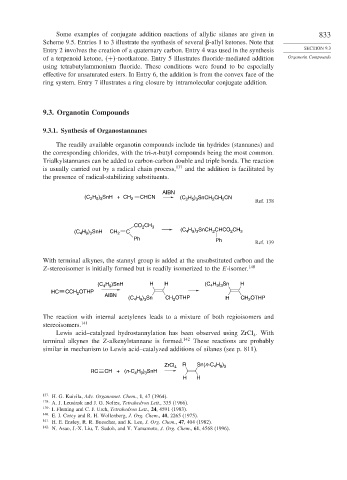Page 857 - Advanced Organic Chemistry Part B - Reactions & Synthesis
P. 857
Some examples of conjugate addition reactions of allylic silanes are given in 833
Scheme 9.5. Entries 1 to 3 illustrate the synthesis of several -allyl ketones. Note that
Entry 2 involves the creation of a quaternary carbon. Entry 4 was used in the synthesis SECTION 9.3
of a terpenoid ketone, + -nootkatone. Entry 5 illustrates fluoride-mediated addition Organotin Compounds
using tetrabutylammonium fluoride. These conditions were found to be especially
effective for unsaturated esters. In Entry 6, the addition is from the convex face of the
ring system. Entry 7 illustrates a ring closure by intramolecular conjugate addition.
9.3. Organotin Compounds
9.3.1. Synthesis of Organostannanes
The readily available organotin compounds include tin hydrides (stannanes) and
the corresponding chlorides, with the tri-n-butyl compounds being the most common.
Trialkylstannanes can be added to carbon-carbon double and triple bonds. The reaction
is usually carried out by a radical chain process, 137 and the addition is facilitated by
the presence of radical-stabilizing substituents.
AIBN
(C H ) SnH + CH 2 CHCN (C 2 5 3
H ) SnCH CH CN
2 5 3
2
2
Ref. 138
CO CH 3
2
H ) SnCH CHCO CH
H ) SnH CH C (C 4 9 3 2 2 3
(C 4 9 3 2
Ph Ph
Ref. 139
With terminal alkynes, the stannyl group is added at the unsubstituted carbon and the
Z-stereoisomer is initially formed but is readily isomerized to the E-isomer. 140
(C H )SnH H H (C H ) Sn H
4 9 3
4 9
HC CCH OTHP
2
AlBN
H ) Sn
(C 4 9 3 CH 2 OTHP H CH 2 OTHP
The reaction with internal acetylenes leads to a mixture of both regioisomers and
stereoisomers. 141
Lewis acid–catalyzed hydrostannylation has been observed using ZrCl . With
4
terminal alkynes the Z-alkenylstannane is formed. 142 These reactions are probably
similar in mechanism to Lewis acid–catalyzed additions of silanes (see p. 811).
R Sn(n-C H )
ZrCl 4 4 9 3
RC CH + (n-C 4 9 3
H ) SnH
H H
137
H. G. Kuivila, Adv. Organomet. Chem., 1, 47 (1964).
138 A. J. Leusinsk and J. G. Noltes, Tetrahedron Lett., 335 (1966).
139
I. Fleming and C. J. Urch, Tetrahedron Lett., 24, 4591 (1983).
140
E. J. Corey and R. H. Wollenberg, J. Org. Chem., 40, 2265 (1975).
141 H. E. Ensley, R. R. Buescher, and K. Lee, J. Org. Chem., 47, 404 (1982).
142
N. Asao, J.-X. Liu, T. Sudoh, and Y. Yamamoto, J. Org. Chem., 61, 4568 (1996).

